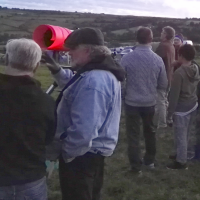 This year’s event was early in the month in an effort to minimise the effect of moonlight. Conditions on the evening were encouraging with cloud forecast to clear away to the south. This turned out to be the case, but was painfully slow so that the moon and Saturn were initially obscured... [Read more about Hook’s House Farm event]
This year’s event was early in the month in an effort to minimise the effect of moonlight. Conditions on the evening were encouraging with cloud forecast to clear away to the south. This turned out to be the case, but was painfully slow so that the moon and Saturn were initially obscured... [Read more about Hook’s House Farm event]
- Log in to post comments

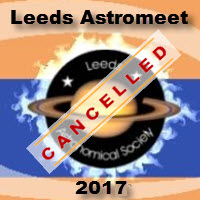 Those of you looking forward to the Leeds Astromeet this year will sadly have to keep looking, cos it’s not on, cancelled, postponed, deceased?..The comment on the Leeds website reads as follows...
Those of you looking forward to the Leeds Astromeet this year will sadly have to keep looking, cos it’s not on, cancelled, postponed, deceased?..The comment on the Leeds website reads as follows... 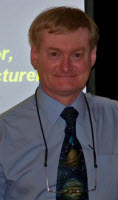 Having finally made contact with Paul, we have pencilled in a date for his postponed talk. Unfortunately it will be 2018 before Paul can make it as he running a WEA course until March of 2018.
Having finally made contact with Paul, we have pencilled in a date for his postponed talk. Unfortunately it will be 2018 before Paul can make it as he running a WEA course until March of 2018. 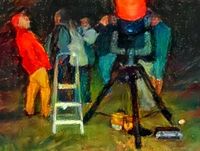 Given that this event was organised for a bank holiday weekend, it was pleasantly surprising to plan for the evening with a high degree of confidence of clear skies. Mark, Andi and Keith made the journey over to Northcliffe holiday park at Hawsker, (Andi and Keith checking out Seaview park en-route), three scopes packed including the LX 200. Once we had negotiated the bollard and gate (don’t ask) leading to the football field, the instruments were set up and we prepared for a great evening’s observation.
Given that this event was organised for a bank holiday weekend, it was pleasantly surprising to plan for the evening with a high degree of confidence of clear skies. Mark, Andi and Keith made the journey over to Northcliffe holiday park at Hawsker, (Andi and Keith checking out Seaview park en-route), three scopes packed including the LX 200. Once we had negotiated the bollard and gate (don’t ask) leading to the football field, the instruments were set up and we prepared for a great evening’s observation. 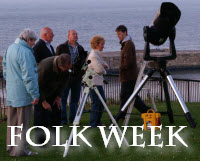
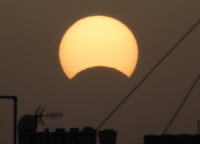 Astronomy fever gripped America in August, where millions were treated to a total solar eclipse. And WDAS was also invited to join in, by a website visitor from Whitby (Ontario), wondering what events we had planned.
Astronomy fever gripped America in August, where millions were treated to a total solar eclipse. And WDAS was also invited to join in, by a website visitor from Whitby (Ontario), wondering what events we had planned.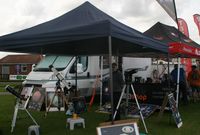 So, what did Mother Nature have in store for this year’s Regatta – the usual mixture of inclement dross, incorrect forecasts and a blank white disk to look at for hours on end! Well, at least any likely showers would fall on a new gazebo, purchased just a few days prior. The old one requires major (but not insurmountable) work to rectify various issues – particularly with the strut frame work – so we thought a new one would be the better option for now.
So, what did Mother Nature have in store for this year’s Regatta – the usual mixture of inclement dross, incorrect forecasts and a blank white disk to look at for hours on end! Well, at least any likely showers would fall on a new gazebo, purchased just a few days prior. The old one requires major (but not insurmountable) work to rectify various issues – particularly with the strut frame work – so we thought a new one would be the better option for now. 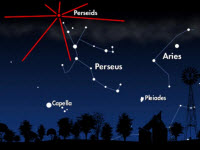 Unless you had stopped up all night, the chances of spotting any shooting stars from our neighbourhood were pretty negligible. The waning gibbous moon would have drowned out most, however cloud cover obscured all! Apparently it did break up sometime in the early morning hours, allowing moonlight to drown out any late meteors. Super!
Unless you had stopped up all night, the chances of spotting any shooting stars from our neighbourhood were pretty negligible. The waning gibbous moon would have drowned out most, however cloud cover obscured all! Apparently it did break up sometime in the early morning hours, allowing moonlight to drown out any late meteors. Super!  Tonight (Sept 1st) is Hooks House night, so if you read this in time and are planning on coming over, weather permitting we aim to be there for around 20:00h. The Moon will be just after First Quarter, Saturn will still be quite well placed, so there should be something on offer for all (weather permitting) and if so it should be a cracking evenin
Tonight (Sept 1st) is Hooks House night, so if you read this in time and are planning on coming over, weather permitting we aim to be there for around 20:00h. The Moon will be just after First Quarter, Saturn will still be quite well placed, so there should be something on offer for all (weather permitting) and if so it should be a cracking evenin 